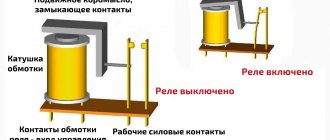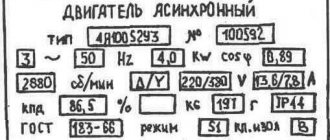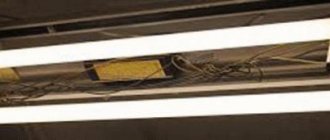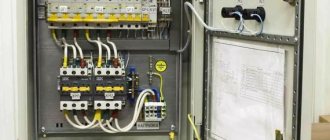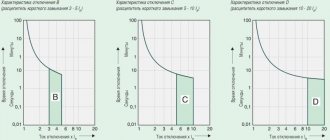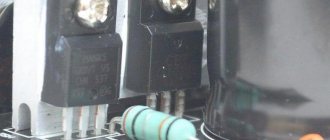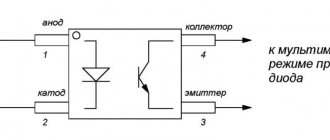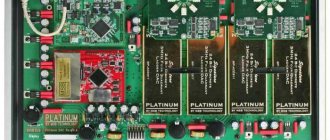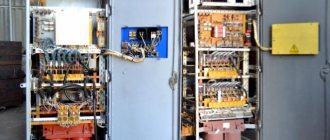Fire protection RCD is a conventional term that characterizes a switch with a differential current sensor and a mechanism for automatically shutting off the line in the event of dangerous leaks. This is the fire-fighting effect that is provided by any RCD. In this case, it is customary to subdivide residual current devices with a sensitivity of 10 - 30 mA to protect people from damage by leakage currents, and a sensitivity of 100 - 300 mA to protect against fire due to poor-quality or damaged insulation.
A fire protection RCD only protects against significant leakage currents that could cause a fire, and it is not intended to protect a person from electric shock.
In this review, we will consider in detail the features of using an RCD with a high setting in the apartment and home electrical supply system and schematic examples of connection in an electrical panel.
Functions of fire protection RCD
The main functions of a fire protection RCD include:
- Monitoring the condition of the input cable and its protection.
- Monitoring and protection of consumer lines in which differential protection is not installed.
- Analysis of the serviceability of the electrical circuit after the module for leakage current through the insulation.
- Redundancy (additional stage of protection) of downstream protections in the event of their failure and the continuing development of the emergency mode.
Let us dwell in more detail on the redundancy function, and note that since the RCD is a high-speed circuit breaker, when using conventional options with a setting of 100 - 300 mA, it will not be possible to ensure selectivity of series-connected residual current devices. Therefore, when the leakage current surges to a multiple value of the rated tripping differential current, in order to avoid simultaneous operation of devices connected in series, the main RCD must have a time delay - selectivity.
As fire-fighting (backup) devices, only selective RCDs of type “S” are used, which have a response time of 120-60 ms.
How can an RCD prevent a fire?
In case of electrical injuries, sparks that can cause a fire are not generated. But a fire can still occur if a leakage current occurs. It's a matter of wiring and electrical current passing through the cables. Initially, the cores are designed for strictly defined voltage values. If these parameters go beyond the design standards, then it won’t be long before an open fire appears.
If a powerful leakage of electric current begins through the broken insulation, then the metal of the wires, which is not designed for this, begins to heat up too much - this leads to the melting of the insulating braid and heating of surrounding objects
The task of the fire protection RCD is to control this situation and prevent overheating of the wiring. If the insulation is damaged and a leakage current has formed, the protective device simply disconnects the problem line from the network. If there is a differential switch in the circuit, the metal cores heat up too much and a fire does not even occur.
The leakage current in the range of 300–500 mA and a voltage of 220 V is the heat generated, equal to the heat generated from a lit household lighter. Such heat generation inevitably leads to ignition of the wiring and everything nearby.
The main function of the class of RCD under consideration is not human protection, but increased fire safety. To prevent electric shock, conventional devices with a lower leakage current rating are placed in the circuit after fire protection devices.
Functionally, the fire protection RCD protects:
- Input cable in front of you.
- Wiring the consumer line after yourself.
- Connected electrical equipment when the standard differential switch located below does not operate in the event of a fault.
The fire protection RCD is part of the cascade protection of the 220 V electrical network. It is not used in smoke and fire monitoring systems. On the contrary, such protective devices should not be present in them. Under certain circumstances, they can disable such a control system, which is completely unacceptable.
Causes of electrical fires
Causes of electrical fires may include:
- Heating of conductors (local or over an extended area) due to overload.
- Sparking at the site of poor electrical contact (in connections, at the terminals of electrical appliances and devices)
- Leakage from non-insulated sections of the circuit (in connection, branch and feed-through boxes, distribution boards, electrical devices).
- The burning of an electric arc in any part of the circuit caused by a short circuit current.
- Damage to cable insulation.
Damage to cable insulation can occur for the following reasons:
- Electrical - from overvoltage and overcurrent.
- Mechanical - impact, pressure, squeezing, bending, damage by a foreign body.
- Environmental influences - humidity, heat, radiation (ultraviolet), aging, chemical exposure.
The development of a short circuit from a leakage current, leading to a fire, occurs as follows:
- At the point of microdamage to the insulation, an extremely small point current begins to flow between energized conductors.
- Under the influence of humidity, pollution, and the penetration of dust over time, a conductive bridge is formed through which leakage current flows.
- As the insulation condition deteriorates, starting from a current value of approximately 1 mA, the conductive channel gradually becomes charred, a “carbon bridge” appears, and the current continuously increases.
- With a leakage current of 150 mA, which corresponds to a power of 33 W, there is a real danger of fire due to the heating of various flammable materials by the heat generated at the site of insulation damage.
What is an RCD in electrical engineering?
Despite the fact that these days electrical wiring is maximally protected from contact with people and sad consequences, there is no escape from leaks. This is where the RCD will become an indispensable assistant. The device will react with lightning speed to an increased current value at the leakage point and cut off the power supply.
RCD is one of the main “cogs” in the protective automation of current electrical networks. The device switches electrical circuits and protects them from currents that flow along conductive paths that are undesirable under standard conditions. This will increase the chances that your home or business will be protected from fires and no one will be harmed by an electric shock.
Note that this device has the function of turning on or off electrical circuits. In other words, it can switch them. Accordingly, the device is a switching one.
Why install an RCD?
Many consumers have heard about the existence of such a miracle device as an RCD, but not everyone knows what it is for. You can understand the general principles of operation of the unit even without deep knowledge of electricity. Until recently, RCDs were not used in residential buildings. But nowadays everything has changed, and now devices are increasingly found in apartments, so it’s worth learning more about them.
As already mentioned, RCDs are installed in order to prevent current leaks that lead to wiring fires and fires. In addition, the RCD will protect you from electric shock, which can lead to significant health problems or, God forbid, death when coming into contact with bare wires and conductive sections of electrical equipment.
NOTE! RCDs differ from automatic circuit breakers that protect wiring from overloads and short circuits; its purpose is to significantly increase the protection of people.
Operating principle of RCD
The operation of the device is based on recording the leakage current to the ground and disconnecting the power grid in the event of such an emergency. The device detects the presence of a leak only by the difference between the currents: those that came out of the device and those that returned back.
If everything is in order with the electrical network, then the currents are identical in magnitude, but differ in direction. As soon as a leak appears - for example, you touched a wire that is not 100% insulated - part of the current goes “to the ground” through another circuit (in this case, through the human body). As a result, the current returning to the RCD through the neutral will be less than that leaving it.
The same thing happens if the insulation in one of the electrical appliances is damaged. Then the housing or other part is under tension. By touching them, a person creates another circuit “to the ground.” In this case, part of the current will move along it, that is, the balance will be destroyed.
Where is the fire protection RCD installed?
To increase the level of fire protection in case of short circuits to grounded parts, when the current value is insufficient to trigger the maximum current protection, it is recommended to install an RCD with an operating current of 100 mA at the entrance to the apartment (house). Devices with a setting of 300 mA are suitable for use in large facilities with many electrical panels and long cable lines.
The protective device is used in multi-level (multi-stage, cascade) circuits as the first stage of differential protection. It is placed in metering panels or in floor distribution panels after the meter. In this case, from the input machine, the phase and working neutral conductors are connected directly to the metering device (electricity meter). Next, after the metering device, a fire protection RCD is installed.
Giving a particular example, it can be noted that the use of a fire protection RCD is especially important in a wooden house that has two or more switchboards. With such a scheme, it is necessary to monitor both the input cable and the transit cables connecting the electrical panels that are not protected by group RCDs.
Equipment selection criteria
Existing RCDs are divided into single-phase and three-phase. Only the first devices are used in everyday life. A single-phase line almost always goes to an apartment or a private house from the electrical panel. For this purpose, a differential switch is used with two terminals (input plus output), whereas three-phase analogues have four terminals for wires.
All RCDs are divided according to the type of leakage current into three groups: “A”, “B” and “AC”. For fire-fighting needs, you should take the “AC” option (only for alternating current), “A” and “B” are more expensive, as they are additionally designed to work with pulsating and rectified currents
Residual current devices are:
- electronic;
- electromechanical.
The former are more expensive, but less reliable. In almost all cases, it is best to take a fire protection RCD of the electromechanical class. This switch does not require external power. If the supply line breaks, the electronic analog stops working and monitors for insulation damage. Plus, during a power surge, its response time increases.
The two main criteria for choosing a fire RCD are the selectivity of the device (the ability to set a shutdown delay) and the high leakage current parameter (100–300 mA). If one of these conditions is not met, then the system of protective devices in the electrical panel will not work as expected.
A selective type RCD is marked on the body with the letter “S”; it is the one that needs to be installed as a fire protection element of the cascade (it switches off with a set time delay)
According to the standards, a fire protection RCD must differ at least three times in a larger direction from the downstream conventional one in:
- leakage current;
- response time.
If the difference in these parameters is less than three times, then when the downstream differential switch is triggered, the fire protection device will also react to disconnect the circuit. As a result, it will be more difficult to find out the cause of the shutdown, and all consumers in parallel lines that have no problems will be left without power.
Ideally, a cascade circuit of various RCDs should work so that when problems arise, only the device that is located closest to the location of the insulation breakdown reacts. In this situation, only the protected circuit is switched off. The rest remain under tension.
With the requirement of a high leakage current parameter, the situation is as follows. For conventional RCDs it is selected within the range of 10–40 milliamps. The operating electric current (maximum consumption by electrical appliances connected to the line) in this case reaches 16–40 A. For lighting and sockets with household appliances, this is quite enough.
However, in any electrical network there are natural leaks. In the project of an intra-apartment or intra-house energy system, they are specially calculated in order to correctly select the RCD. They should not exceed 1/3 of the leakage current of the selected differential switch for a particular line. Otherwise, the protective device will trigger falsely on a regular basis.
According to the rules, a fire protection RCD is installed immediately after the electric meter at the entrance to the house; it sums up the natural electrical leakages from all household appliances connected to the home
If the protective device is selected, as for the usual case, at 10–40 mA, then the power supply will be permanently disconnected. In fact, the RCD will continuously detect leaks, triggering a power shutdown in all power supply lines of the house.
Operating principle of fire protection RCD
The operating principle of both fire-fighting and conventional RCDs is the same, based on the constant comparison of current vectors flowing through the phase and neutral conductors.
Operating principle of RCD
Let's take a closer look at this mechanism:
- In normal power supply mode, when the current vectors are equal, the induced magnetic fluxes from each wire, adding up in the magnetic circuit, destroy each other.
- When a leak occurs, the current in the working neutral conductor decreases by its value.
- The total magnetic flux changes in proportion to the leakage. It induces an electromotive force (EMF) in the magnetic circuit coil.
- Under the influence of EMF, the executive relay KL is activated. It completely removes power from the protected line.
RCDs for general use, with high speed, are designed to protect people from electric shock. A fire protection RCD has an increased response setting of 100 or 300 milliamps and, accordingly, lower response speed. This difference is clearly demonstrated in the following graph:
| Time-current characteristics of RCD | |
| 1 - time-current characteristic of RCD type “S” (IΔn = 300 mA) | |
| 2 - time-current characteristic of RCDs for general use (IΔn = 30 mA) | |
A fire protection RCD with a sensitivity of 100 - 300 mA will prevent a short circuit and prevent a fire by de-energizing the entire building until the current leak is eliminated. And such devices with rough cutoff primarily cover those sections of the network that are not protected by general-purpose RCDs.
How to choose an RCD for an apartment or private house?
The purpose of an RCD has already been discussed several times, and its installation in a modern household electrical network is definitely the most important protection for a person from electric shock. But how to choose an RCD? Based on what parameters? How to calculate a device for a particular protected consumer? Let's try to figure it all out.
To make the right choice of RCD, you need to understand its purpose, main characteristics and parameters. When you buy a device, pay attention to its case, all the important information is indicated there. So that these numbers and letters tell you something, we will analyze each of them separately.
Purpose
The most important thing to understand is that a circuit breaker protects the electrical network from overcurrents, and an RCD provides human protection. If, as a result of an insulation breakdown, potential appears on the body of an electrical appliance, touching it is likely to result in an electric shock. To prevent this from happening, immediately when a current leak occurs, the protective shutdown device will react and turn off the damaged section of the circuit.
It is important to know! RCDs do not protect against overloads and short circuits, so circuit breakers must be connected in series with them in the circuit.
Trademark
Speaking about the brand, we will essentially analyze the price-quality ratio. The fact is that there is an unspoken classification of all RCD manufacturers according to their territorial location - European models, Asian and Russian.
One way to spot a fake video:
Each of their products has its own characteristic features:
- Both a fire-fighting RCD and a device that protects people from electric shock produced in Europe will cost an order of magnitude more than models from Russia and China. But this price guarantees quality and reliability. It will not be amiss to know that some European companies, in addition to the main high-quality assortment, produce RCDs for the markets of other countries with the same reliability, but with reduced technical characteristics.
- Domestic manufacturers offer RCDs at a lower price than their counterparts from Europe, however, they meet all regulatory requirements of Russian standards. So far, Russian manufacturers' sales network is not so strong, and the devices themselves are not able to compete with Asians in price or with Europe in terms of quality.
- RCDs from Asian manufacturers are in greatest demand in the world. Some manufacturers from Asia enter into contracts with suppliers of products to the Russian market and in this case produce devices under the Russian brand.
Before choosing an RCD brand, decide what means you have for installing automatic protective equipment in an apartment or private house. Most preferred companies:
- Swiss "ABB";
- French Legrand and Schneider Electric;
- German "Siemens" and "Moeller".
Among domestic manufacturers, the most widely used products are:
- Kursky, average price and quality, the company gives a two-year guarantee for the RCDs produced, which indicates the reliability of the products;
- Moscow (“IEC”), products do not always receive positive reviews, however, the demand for it is high due to its low cost;
- Ulyanovsk, it is part of the group, which affects the quality of the products and, accordingly, the price;
- relatively young St. Petersburg, on the Russian market it represents the world-famous company “Schneider Electric”.
As for Chinese manufacturers, the RCDs they produce are a direct competitor to Russian devices. Price and quality are approximately at the same level, while the warranty period for Chinese goods is five years.
Fire safety of electrical installations
Let us highlight information from regulatory documents that regulate the use of RCDs to ensure fire safety of electrical installations of buildings, structures and structures:
| PUE 7. Rules for electrical installations. Edition 7 | 7.1.83. The total leakage current of the network, taking into account the connected stationary and portable electrical receivers in normal operation, should not exceed 1/3 of the rated current of the RCD. In the absence of data, the leakage current of electrical receivers should be taken at the rate of 0.4 mA per 1 A of load current, and the network leakage current at the rate of 10 μA per 1 m of phase conductor length. 7.1.84. To increase the level of fire protection in case of short circuits to grounded parts, when the current value is insufficient to trigger the maximum current protection, it is recommended to install an RCD with an operating current of up to 300 mA at the entrance to an apartment or individual house. 7.1.85. For residential buildings, when the requirements of clause 7.1.83 are met, the functions of the RCD according to clauses. 7.1.79 and 7.1.84 can be performed by one device with an operating current of no more than 30 mA. |
| Federal Law “Technical Regulations on Fire Safety Requirements” dated July 22, 2008 N 123-FZ | Article 82, paragraph 4. Power supply lines of premises of buildings, structures and structures must have protective shutdown devices that prevent the occurrence of a fire in the event of a malfunction of electrical receivers. The installation rules and parameters of residual current devices must take into account the fire safety requirements established in accordance with this Federal Law. |
| GOST R 53312-2009 SAFETY DISCONNECTION DEVICES Fire safety requirements. Test methods | p 6 The following buildings and structures are subject to equipping with residual current devices to prevent fires from electrical installations: Residential buildings:
|
| SP 31-110-2003 Design and installation of electrical installations of residential and public buildings | Appendix A.1.7. The use of RCDs for existing residential buildings with two-wire networks, where electrical receivers do not have protective grounding, is an effective means of increasing electrical safety. Triggering of an RCD during a short circuit to the housing in such networks occurs only when a differential current appears, that is, upon direct contact with the housing (connection to the “ground”). In accordance with this, the installation of an RCD can be recommended as a temporary measure to improve safety until a complete reconstruction is carried out. The decision to install an RCD must be made on a case-by-case basis after obtaining objective data on the condition of the electrical wiring and bringing the equipment into good condition. Appendix A.5.1. Single-family houses, country houses and garden houses must be subject to increased electrical safety requirements, which is due to their high energy saturation, extensive electrical networks and the specific operation of both the objects themselves and the electrical equipment, since in most cases the electrical equipment is not assigned to qualified, permanent operating services. |
Main settings
After the trademark, the main ratings and performance characteristics of the RCD are indicated on the body.
- Model name and series. Please note that here you will not always see the letters RCD; some manufacturers designate this device as a VDT (residual current switch).
- The value of the rated voltage and frequency. In the Russian power system, the operating frequency is 50 Hz. As for voltage, for a single-phase network in an apartment it is 220-230 V. For a private house, a three-phase network is sometimes needed and the operating voltage will be 380 V.
Characteristics of the RCD in the video:
- The rated operating current is the maximum value that the RCD is capable of switching.
- Rated differential current. This is the value at which the device is triggered.
- The temperature limits of the RCD operation are also indicated here (minimum - 25 degrees, maximum + 40).
- Another current value is the rated conditional short-circuit current. This is the maximum short circuit current that the device will withstand and not turn off, but provided that a suitable circuit breaker is installed in series with it.
- Nominal response time. This is the time period from the moment when a current leak suddenly occurs until it must be extinguished by all poles of the RCD. The maximum permissible value is 0.03 s.
- The RCD diagram must be drawn on the housing.
